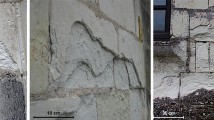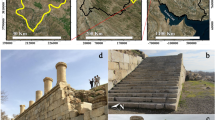Abstract
The main cause of degradation in tuffeau, a soft siliceous and clayey limestone extensively used in the construction of the castles of the Loire Valley in France, is scaling. The most damaging form of weathering is spalling. Over time, a plaque several centimetres in thickness gradually forms under the stone surface and eventually falls away, leaving the resulting new surface powdered. Hypotheses regarding the initiation and development of such degradation have not yet met scientific consensus. The objective of the present paper is to improve existing knowledge of scaling degradation by analysing in situ samples representing different stages of the same degradation process. The analysis of the stones at the Castle of Chambord, revealed the presence of gypsum (CaSO4·2H2O), mainly located in cracks parallel to the stone surface. This gypsum was then studied in terms of its crystal morphology and distribution with depth. For comparison purposes, another form of scaling identified at the Castle of Chambord but rarely studied, flaking, was also examined. A first attempt at explaining the origin and formation of the observed gypsum in both scaling processes was conducted by interacting and comparing the characterisation results with historical and environmental data.






Similar content being viewed by others
References
Al-Omari A, Brunetaud X, Al-Mukhtar M (2013) Effect of thermal stress, condensation and freezing–thawing action on the degradation of stones on the Castle of Chambord, France. Environ Earth Sci, doi: 10.1007/s12665-013-2782-4
Beck K, Al-Mukhtar M (2010) Weathering effects in an urban environment: a case study of tuffeau, a French porous limestone. Geological Soc Lond Special Publ 331:103–111
Beck K, Al-Mukhtar M (2013) Cyclic wetting-drying ageing test and patina formation on tuffeau limestone. Environ Earth Sci, doi: 10.1007/s12665-013-2637-z
Beck K, Al-Mukhtar M, Rozenbaum O, Rautureau M (2003) Characterization, water transfer properties and deterioration in tuffeau: building material in the Loire Valley-France. Build Environ 38:1151–1162
Belayachi N, Hoxha D, Do DP (2012) Thermo-hydro-mechanical behaviour of tuffeau stone masonry. Eur J Environ Civ Eng 16(5):557–570
Benavente D, Cultrone G, Gomez-Heras M (2008) The combined influence of mineralogical, hygric and thermal properties on the durability of porous building stones. Eur J Mineral 20:673–685
Berthonneau J, Grauby O, Bromblet P, Vallet JM, Dessandier D, Baronnet A (2012) Role of swelling clay minerals in the spalling decay mechanism of the « pierre du midi » limestone (South-East of France). 12th International Congress on the Deterioration and Conservation of Stone. 22–26 October 2012 New York, États-Unis
Birginie JM, Auger F, Rivas BT (2000) Changes in the permeability to gas of calcareous stone core samples exposed to salt spray. Mater Struct 33:331–337
Brunet-Imbault B (1999) Etude des patines de pierres calcaires mises en œuvre en région Centre. French Ph-D thesis, University of Orléans
Camuffo D (1995) Physical weathering of stones. Sci Total Environ 167(1–3):1–14
Cautru JP (1976) Le Tuffeau de Touraine—Étude de son altération. French report BRGM of Orléans 76 SGN 012 MTX
Colas E, Mertz JD, Thomachot-Schneider C, Barbin V, Rassineux F (2011) Influence of the clay coating properties on the dilation behavior of sandstones. Appl Clay Sci 52(3):245–252
Craddock PR, Rouxel OJ, Ball LA, Bach W (2008) Sulfur isotope measurement of sulfate and sulfide by High-resolution MC-ICP-MS. Chem Geol 253(3–4):102–113
Derbez M (1999) Rôle des apports atmosphériques dans l’altération de calcaires tendres en environnement urbain : la cathédrale de Tours. French Ph-D thesis, University of Paris XII
Dessandier D (1995) Etude du milieu poreux et des propriétés de transfert des fluides du tuffeau blanc de Touraine. Application à la durabilité des pierres en œuvre. French Ph-D thesis, University of Tours
Dessandier D (2000) Guide méthodologique des monuments en termes de durabilité et compatibilité. collaboration with Auger P and Haas H. French report BRGM
Félix C (1985) Altérations Desquamantes et Composés Soufrés d’origine Atmosphérique: Cas des Grès tendres Molassiques de quelques Monuments Lausannois. 5e congrès international sur l’altération et la conservation de la pierre. 25–27 septembre 1985 Lausanne, Suisse, pp 391–409
Hammecker C (1993) Importance des transferts d’eau dans la dégradation des pierres en œuvre. French Ph-D thesis, University Louis Pasteur
Janvier-Badosa S (2012) Le carnet de santé d’un monument, application au château de Chambord, French Ph-D thesis, University of Orléans, France
Janvier-Badosa S, Beck K, Brunetaud X, Al-Mukhtar M (2013) Historical study of Chambord castle: a basis for establishing the health record of the monument. Int J Archit Heritage 7(3):247–260
Jeannette D (1992) Morphologie et nomenclature des altérations. In: Philippon J, Jeannette D, et Lefèvre RA (eds.) La conservation de la pierre monumentale en France, presses du CNRS, pp 51–72
Jeannette D, Brillanceau A, Louail J, Macaire JJ, Ozouf JC (1985) Etude préliminaire des altérations des tuffeaux du Saumurois et du Chinonais. French report 1985, LRMH P528
Kloppmann W, Bromblet P, Vallet JM, Vergès-Belmin V, Rolland O, Guerrot C, Gosselin C (2011) Building materials as intrinsic sources of sulphate: a hidden face of salt weathering of historical monuments investigated through multi-isotope tracing (B, O, S). Sci Total Environ 409(9):1658–1669
Lazzarini L, Tabasso ML (1989) La Restauration de la Pierre. Trad. italian by Philippon J. ERG Edition
McGreevy JP, Smith BJ (1984) The possible role of clay minerals in salt weathering. Catena 11:169–175
Pauly JP (1990) Altération de la Pierre en œuvre en relation avec la climatologie et l’architecture, simulation et produits de protection. French Ph-D thesis, Institut National Polytechnique de Loraine
Rautureau M (2001) Tendre comme la pierre, collective book, directed by Michel Rautureau. ed Conseil Régional Centre and University of Orléans
Rigo C (1990) Étude de l’altération des matériaux pierreux en œuvre en Région Centre—Caractérisation chimique et pétrophysique des tuffeaux et de leur dégradation. French Ph-D thesis, University of Orléans
Sabbioni C (1995) Contribution of atmospheric deposition to the formation of damage layers. Sci Total Environ 167: 1–3: 49–55
Sanjurjo Sánchez J, Romaní JRV, Alves C (2011) Deposition of particles on gypsum-rich coatings of Historic Buildings in urban and rural environments. Constr Building Mater 25(2):813–822
Sebastian E, Cultrone G, Benavente D, Fernandez L, Elert K, Rodriguez-Navarro C (2008) Swelling damage in clay-rich sandstones used in the church of San Mateo in Tarifa (Spain). J Cult Heritage 9:66–76
Siedel H, Klemm W (2000) Evaluation of the environmental influence on sulphate salt formation at Monuments in Dresden (Germany) by sulphur isotope measurements. 9th International Congress on Deterioration and Conservation of Stone 401–409
Smith BJ, Gomez-Heras M, Viles HA (2010) Underlying issues on the selection, use and conservation of building limestone. Geol Soc Spec Pub 331:1–11
Smith BJ, Srinivasan S, Gomez-Heras M, Basheer PAM, Viles HA (2011) Near-surface temperature cycling of stone and its implications for scales of surface deterioration. Geomorphology 130:76–82
Török Á (2003) Surface strength and mineralogy of weathering crusts on limestone buildings in Budapest. Build Environ 38(9–10):1185–1192
Török Á, Licha T, Simon K, Siegesmund S (2011) Urban and rural limestone weathering; the contribution of dust to black crust formation. Environ Earth Sci 63(4):675–693
Vallet JM, Gosselin C, Bromblet P, Rolland O, Vergès-Belmin V, Kloppmann W (2006) Origin of salts in stone monument degradation using sulphur and oxygen isotopes: first results of the Bourges cathedral (France). J Geochem Explor 88(1–3):358–362
Vergès-Belmin V (2001) Altération des pierres mises en œuvre. In: Schrefler et Delage, (eds) Géomécanique environnementale, risques naturels et patrimoine, Hermès Science publication, pp 191–235
Wendler E, Klemm DD, Snethlage R (1990) Contour scaling on building facades—Dependence on stonetype and environmental conditions. Analytical Methodologies for the Investigation of Damaged Stones. 14–21 september 1990. Pavia, Italy
Author information
Authors and Affiliations
Corresponding author
Rights and permissions
About this article
Cite this article
Janvier-Badosa, S., Beck, K., Brunetaud, X. et al. The occurrence of gypsum in the scaling of stones at the Castle of Chambord (France). Environ Earth Sci 71, 4751–4759 (2014). https://doi.org/10.1007/s12665-013-2865-2
Received:
Accepted:
Published:
Issue Date:
DOI: https://doi.org/10.1007/s12665-013-2865-2




